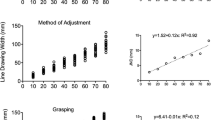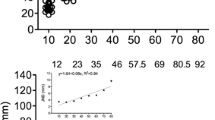Abstract
Humans decide how to carry out a spontaneous interaction with an object by using the whole geometric information obtained from their eyes. The aim of this paper is to present how our object representation model MWS (Adán in Comput Vis Image Underst 79:281–307, 2000) can help a robot manipulator to make a single and reliable interaction. The contribution of this paper is particularly focused on the grasp synthesis stage. The main idea is that the grasping system, through MWS, can use non-strict-local features of the contact points to find a consistent grasping configuration. The Direction Kernels (DK) concept, which is integrated into the MWS model, is used to define a set of candidate contact-points and interaction regions. The set of DK is a global feature which represents the principal normal vectors of the object and their relative weight in a three-connectivity mesh model. Our method calculates the optimal grasp points (which are ordered according to the quality function) for two-finger grippers, whilst maintaining the requirements of force closure and safety of the grasp. Our strategy has been extensively tested on real free-shape objects using a 6 DOF industrial robot.
Similar content being viewed by others
References
Cutkosky M.R.: On grasp choice, grasp models and the design of hands for manufacturing tasks. IEEE Trans. Robot. Autom. 5(3), 269–279 (1989)
Nguyen, V.D.: Constructing stable grasps in 3D. In: IEEE International Conference on Robotics and Automation, vol. 4 (1987)
Ferrari, C., Canny, J.: Planning optimal grasps. IEEE ICRA, Nice, pp. 2290–2295 (1992)
Borst, C., Fisher, M., Hirzinger, G.: A fast and robust grasps planner for arbitrary 3D objects. IEEE ICRA 1999, Detroit, pp. 1890–1896
Pollard, N.: Synthesizing grasps from generalized prototypes. IEEE ICRA, Minneapolis, pp. 2124–2130 (1996)
Miller, A.T., Allen, P.K.: Examples of 3D Grasp Quality computations. In: IEEE International Conference on Robotics and Automation (ICRA), pp. 1240–1246 (1999)
Ponce J. Faverjon B.: On computing three finger force-closure grasps of polyhedral objects. IEEE Trans. Robot. Autom. 11(6), 868–881 (1995)
Ding, D. Liu Y., Wang S.: Computing 3D optimal form-closure grasps. IEEE ICRA, San Francisco, pp. 3573–3578 (2000)
Chinellato, E., Fisher, R.B., Morales, A., Pobil, A.P.: Ranking planar grasp configurations for a three-finger hand. In: IEEE International Conference on Robotics and Automation (ICRA), pp. 1133–1139 (2003)
Prado-Gardini, R., Suárez, R.: Heuristic approach to construct 3-finger force-closure grasp for polyhedral objects. In: 7th IFAC Symposium on Robot Control (SYROCO’2003), pp. 387–392 (2003)
Sanz, P.J., Marín, R., Dabic, S.: Improving 2D visually-guided grasping performance by jeans of new geometric computation techniques. In: Intelligent Manipulation and Grasping, Genova, Italy, pp. 559–654 (2004)
Kawarazaki, N., Hesegawa, T., Nishihara, Z.: Grasp planning algorithm for a multifingered hand-arm robot. In: IEEE ICRA, Leuven, pp. 933–939 (1998)
Fernandez, C., Vicente, A., Reinoso, O., Aracil, R.: A decision tree based approach to grasp synthesis. In: Intelligent Manipulation and Grasping, Genova, Italy, pp. 486–491 (2004)
Morales, A., Chinellato, E., Sanz, P.J., Fagg, A.H., del Pobil, A.P.: Vision based planar grasp synthesis and reliability assessment for a multifinger robot hand: a learning approach. In: Intelligent Manipulation and Grasping, pp. 566–570 (2004)
Pelossof, R., Miller, A., Allen, P., Jebara, T.: An SVM learning approach to robotic grasping. In: IEEE International Conference on Robotics and Automation (ICRA), pp. 3215–3218 (2004)
Michel, C., Remond, C., Perdereau, V., Drouin, M.: A robotic planner based on the natural grasping axis. In: Intelligent Manipulation and Grasping, Genova, Italy, pp. 492–497 (2004)
Miller, A., Knoop, S., Christensen, H.I., Allen, P.K.: Automatic grasp planning using primitives. In: IEEE International Conference on Robotics and Automation (ICRA), pp. 1824–1829 (2003)
Adán A., Cerrada C., Feliu V.: Modeling wave set: definition and application of a new topological organization for 3D object modeling. Comput. Vis. Image Underst. 79, 281–307 (2000)
Adán, A., Adán, M.: A flexible similarity measure for 3D shapes recognition. In: IEEE Transactions on Pattern Analysis and Machine Intelligence (Nov. 2004)
Merchán P., Adán A.: Exploration Trees on Highly Complex Scenes: A New Approach for 3D Segmentation. Pattern Recognit. 40(7), 1879–1898 (2007)
Merchan, P., Adán, A., Salamanca, S.: Recognition of free-form objects in complex scenes using DGI-BS models. In: Third International Symposium on 3D Data Processing, Visualization and Transmission, 3DPVT, Chapel Hill, USA (2006)
Vázquez, A.S., Torres, R., Adán, A., Cerrada, C.: Path planning for manipulation environments through interpolated walks. In: International Conference on Intelligent Robots and Systems (IROS’06), Beijing, China
Vazquez, A.: Robot interaction in 3D environment: new approaches on integration architectures, path planning and grasping. PhD thesis, Castilla La Mancha University (2008)
Author information
Authors and Affiliations
Corresponding author
Rights and permissions
About this article
Cite this article
Adán, A., Vázquez, A.S., Merchán, P. et al. Direction Kernels: using a simplified 3D model representation for grasping. Machine Vision and Applications 24, 351–370 (2013). https://doi.org/10.1007/s00138-011-0351-y
Received:
Revised:
Accepted:
Published:
Issue Date:
DOI: https://doi.org/10.1007/s00138-011-0351-y




